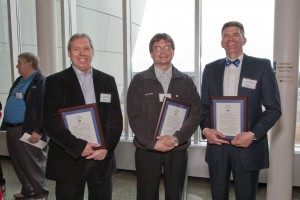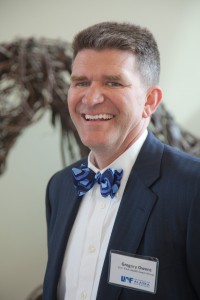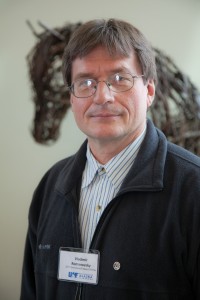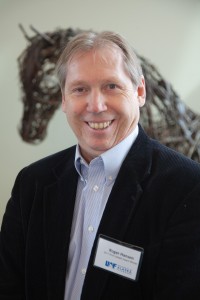University honors 2011 Usibelli Award recipients
May 3, 2011

907-474-7902
4/3/11
The University of Alaska Fairbanks has announced recipients of the 2011 Emil Usibelli Distinguished Teaching, Research and Public Service Awards.
Gregory Owens, associate professor of mathematics in the College of Rural and Community Development, received the teaching award; Vladimir Romanovsky, professor of geophysics in the College of Natural Science and Mathematics and the Geophysical Institute, received the research award; and Roger Hansen, research professor at the Geophysical Institute and state seismologist and director at the Alaska Earthquake Information Center, received the service award. All three were honored at a reception Monday at the UA Museum of the North.

“It is his calling and his passion and the students who have benefited from his excellent skills and dedication are now contributing to engineering firms, businesses, schools, tribal organizations and other roles in small and large communities across the state and beyond,” said Sue McHenry, who nominated Owens. “Because he consistently challenges students to stretch themselves past what they may feel their limits are, he teaches more than mathematics, and he impacts how his students view themselves and even how they challenge their children to set goals.”
His skills as an educator are well documented in more than a dozen letters from former students. They cite not only his effectiveness in teaching mathematical concepts, but also his profound effect on their self-confidence, academically, professionally and personally.
“Throughout it all, I have never lost sight of my primary task,” Owens said. “I’m still striving to improve the success rates of students in my classes and their subsequent math courses, because the goal of developmental education is to prepare a capable and diligent lifetime student.”
Owens holds a bachelor’s degree in mathematics from the University of Wisconsin-Platteville and a master’s degree in cross-cultural education from UAF.

He began his career in 1975 at Moscow State University. In 1992, he came to UAF as a research assistant at the Geophysical Institute.
His research and collaborative work monitoring permafrost in northern latitudes has provided an important record of change in the Arctic and subarctic and has added to worldwide understanding of climate change. His work also offers valuable contributions to the state.
“The progressive destabilization of some soils, besides directly documenting change in mean annual air temperature, will have dramatic effects on the man-made infrastructure of the Interior,” wrote geology and geophysics department chairman Bernard Oakley in his nomination letter. “Vlad’s work contributes directly to our ability to plan and effectively remediate effects on roads and buildings that are being compromised by the changing climate and plan future construction to minimize these impacts.”
As part of his research work during the last five years, Romanovsky has mentored 22 students and nine postdoctoral researchers and has been listed on more the $10 million in research grants, many of them with an interdisciplinary focus. He also teaches both graduate and undergraduate courses and incorporates his interdisciplinary philosophy into his teaching and service work.
“We are actively collaborating with biologists, soil scientists, hydrologists, biogeochemists, marine scientists, remote sensing scientists and others to promote the system science approach in developing a better understanding of the Arctic,” Romanovsky said.
Romanovsky holds master’s degrees in mathematics and geophysics and a doctorate in geology from Moscow State University and a doctorate in geophysics from UAF.

“At the time, there was little effort made to report information outside the research community,” Hansen said, noting that current practice is quite different. “Response agencies receive critical information about damaging earthquakes in minutes, if not second, via web pages, email, text messages, and fax and telephone. Additionally, using our tsunami modeling capabilities, we are distributing information for the development of evacuation routes and safe zones throughout Alaska’s vulnerable coastal communities.”
Hansen’s outreach and public information efforts cover a wide swath of the population, from public and school tours of his facility, to informational pamphlets and electronic media, to teacher education, to public lectures and media interviews. He serves on multiple public emergency-planning and hazard-mitigation committees and is frequently consulted as an expert in his field. In addition to his public service, he is active on a variety of university committees, all while continuing his own research activities and mentoring graduate students.
Alaska’s seismic observatory is the busiest in the nation, said Geophysical Institute director Roger Smith, who nominated Hansen for the award.
“The measures of success of the observatory are precision of the data, the accuracy of calculations and reliability of the reports,” Smith said. “Under the leadership of Dr. Roger Hansen, the Alaska Earthquake Information Center strives for excellence in these areas and provides outstanding service to the state, nation and the seismological profession.”
Hansen holds bachelor’s, master’s and doctoral degrees from the University of California, Berkeley.
The Emil Usibelli Distinguished Teaching, Research and Public Service Awards are considered one of the university’s most prestigious awards. They represent UAF’s tripartite mission and are funded annually from a $600,000 endowment established by Usibelli Coal Mine in 1992.
Each year, a committee that includes members from the faculty, the student body and a member of the UA Foundation Board of Trustees evaluates the nominees. Each of the winners receives a cash award of $10,000.
NOTE TO EDITORS: Photos of the recipients are available online at www.uafnews.com.
MG/5-3-11/220-11


